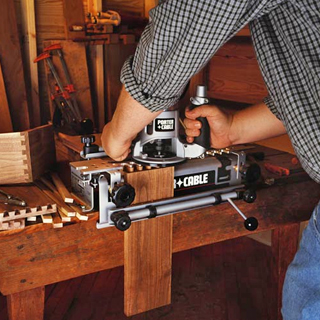
I have a project that I am making a case for drawers. The case is going to have through dovetails. My problem is the length of the boards with the pins. They are 65 inches long. I am using a Porter-Cable 4210 jig which calls for the pin boards, and the tail boards, for that matter, to be mounted vertically. No problem with the 5-inch tailboards. But the long boards would basically put this operation over my head. Do you have any ideas as to how to cut these? My first inclination is to build a right-angle base for the dovetail jig which allows me to mount the jig so that the vertical clamp is then horizontal. The issue then seems to be one of safety as the router would have to be utilized in an orientation that is 90 degrees from normal operating form.
Any help/advice would be greatly appreciated. I am assuming people have had similar issues before. – Douglas J. Heckler
Rob Johnstone: Well Doug, you are actually the first person who has mentioned this limitation to me — but I would think you are a correct that you are not the first person to confront the problem. If you are going to use the P-C jig (or any similar product), its limits will constrain you in any number of ways — dovetail spacing is one example, this length issue is another. I think your solution of creating a fixture to hold the jig and the long material at 90-degrees is your best solution. I would test it out on scrap stock … but if you wore a protective face shield and worked through the process carefully, it would be awkward, but doable. You could look into cutting the dovetails (pins and tails) on a band saw. I have not done it personally, but I have read several articles on the subject, and it might be just the ticket. You would likely need to do a bit of fitting with a chisel … but if it was my project, I think I would give it consideration.
Chris Marshall: I appreciate your inventiveness, but given that routing through dovetails accurately is challenging enough in itself, I would be inclined to figure out a way to keep that jig in its conventional orientation and change the “me” aspect of it. In other words, I might try to mount my jig and workpieces to, say, a deck railing on an elevated deck that allows me clearance to hang the longer stock down. Then I’d stand on the deck as though it were a shop floor. Think of it as a workbench with really long legs! I know this might (and may well be) impossible for you if you don’t have a deck, but it would at least allow you to work at a comfortable standing position with the jig clamped to the railing and oriented in the typical way. Or, you could build a tall workstation pretty quickly from 2x material and fashion a sturdy box platform or use a ladder to stand on, in order to bring you up to comfortable working height — again, keeping the jig and workpieces set up in the way the jig was designed to be used. If you follow your inclination to make a right-angle fixture for your dovetail jig instead, do let us know how that works out. It might come in handy for another woodworker down the road. But above all, work safely.





